This article also appears in Canadian Developer Connection.

Robots competing at the finals of the FIRST Robotics Greater Toronto Regional Competition
The FIRST Robotics Greater Toronto Regional Competition took place last Friday and Saturday, and I had the opportunity to catch the finals on Saturday afternoon. The organizers invited me as representative of Microsoft Canada and were kind enough to give me a VIP pass, which gave me access to places that the regular audience couldn’t go, including right up to the edge of the playing field and “the pit”, where competitors tuned up their robots prior to the competition.
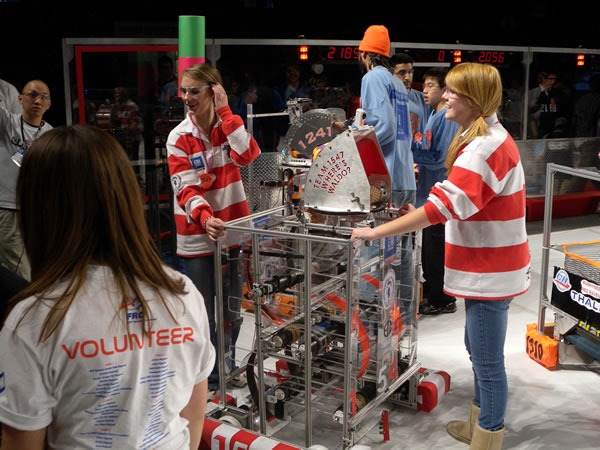
The “Where’s Waldo?” team takes their robot onto the field for a match.
FIRST stands for For Inspiration and Recognition of Science and Technology, and like the Segway, it’s the creation of inventor Dean Kamen. Its purposes are:
- To inspire high school students to go into engineering and technology studies
- To promote a philosophy of collaboration and teamwork among techies
- To encourage a sense of gracious professionalism, fair play and helping each other out even during intense competition
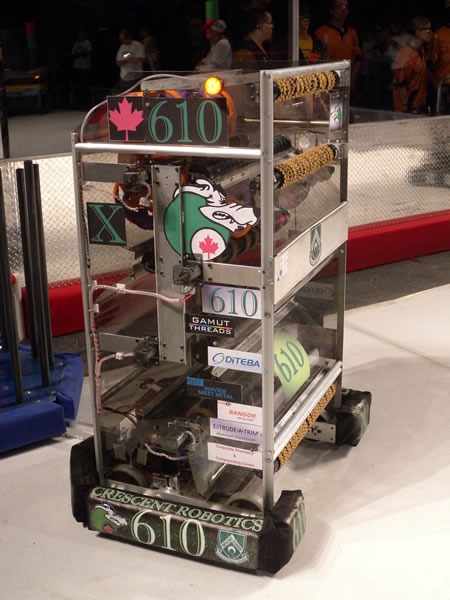
Crescent School’s robot.
While on the surface FIRST would seem to be about building robots, Kamen says that what it’s really about is getting young people interested in engineering in a fun and interesting way.
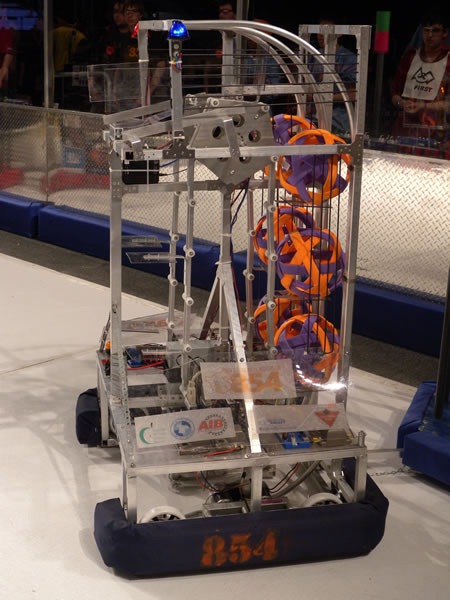
The Robots and the Game
All robots in the FIRST Robotics competition are built from a standard “kit” of parts and must fall within a set of specifications – no taller than 6 feet, a “footprint” of no more than 3 feet by 2 feet and a weight limit of around 120 pounds. Here’s one of the robots from the competition:
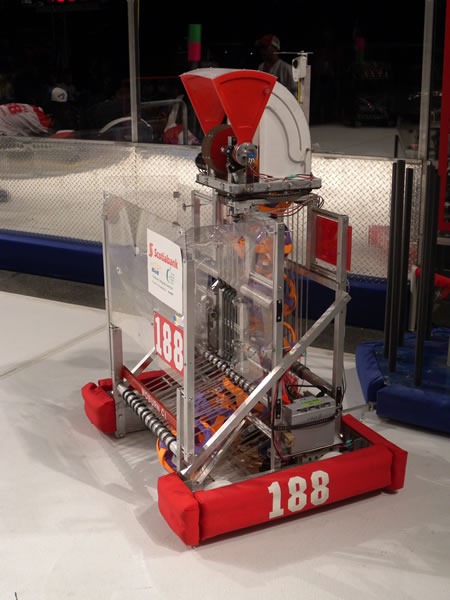
The game played by the robots changes each year. This year’s game, called Lunacy, is inspired by this year being the 40th anniversary of the first manned mission to the moon. The video below explains the rules of the game:
As mentioned in the video, the surface of the playing field – called “The Crater” – is covered in a polymer called regolith (the term for loose heterogeneous material covering solid rock, like that on the moon). Here’s a closeup of that surface:

The robots’ wheels, shown below, are made of a material that offers only a little traction when used on regolith. The combination of the wheels and regolith simulate the low-traction conditions of driving a vehicle in lunar conditions — on fine moon dust in one sixth of Earth’s gravity:

One of the technical hurdles that the students had to overcome was dealing with the traction problems that come with piloting a robot with these wheels running on regolith. Some teams wrote traction control code that would detect if any wheel was spinning faster than the others (meaning that it was slipping) and then compensate for it.
Robots score points by shooting balls – called “moon rocks”, and “super cells”, each worth a different number of points – into trailers pulled by the opposing team’s robots. Here’s what the moon rocks look like:

Robots can start with an initial payload of 7 moon rocks, and if their designers see fit, they can be designed to collect stray moon rocks on the playing field. In the photo below, taken just before a match, the robot is pre-loaded with moon rocks to dump into another robot’s trailer. Note the intake on its front end for collecting stray moon rocks:
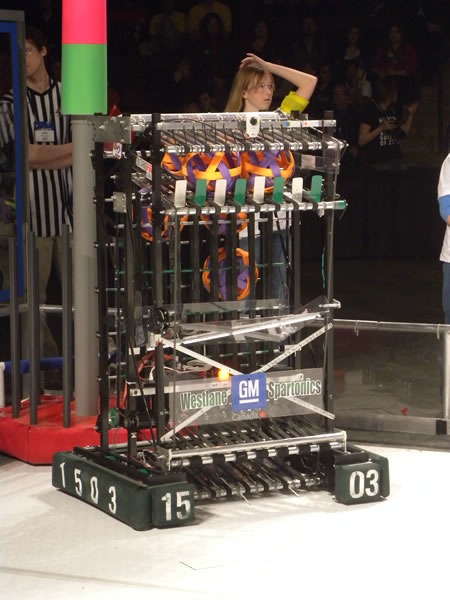
Here’s a photo of a student attaching a trailer to a robot: Each trailer has a pink and green marker on top; it’s a target that allows robots equipped with cameras to locate it during the first 15 seconds of the game, when they must operate in “autonomous mode” (that is, under their own control, rather than remote control by a human operator).
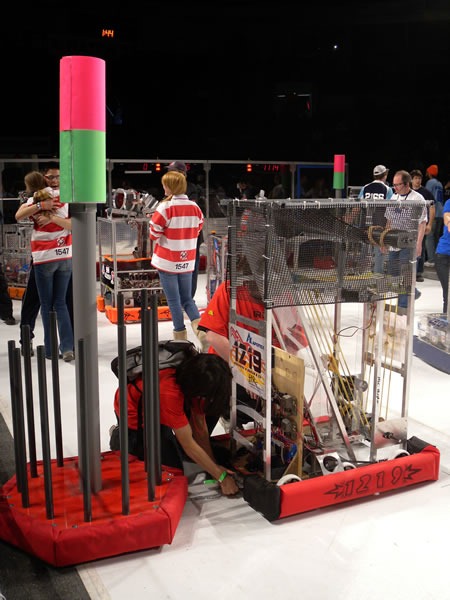
After the first 15 seconds, the robots switch from autonomous mode to human remote control. Each team has a standard remote control transmitter to which they can attach control devices of their own choosing. Some teams favoured joysticks and a basic setup:
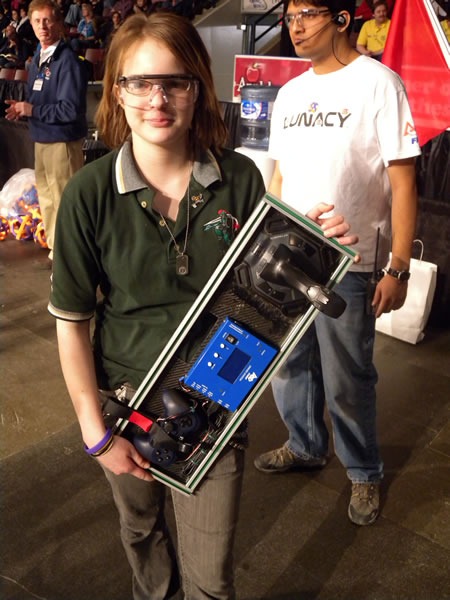
…while others preferred controllers for modern-day gaming consoles (and even dressing up the standard transmitter in the shell of an XBox 360):
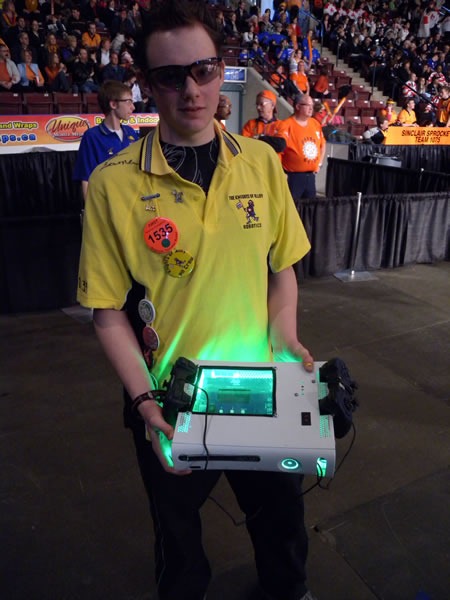
This may have been an engineering and technology event, but it had the atmosphere and energy of a pep rally. The stands were packed with fans:

and cheerleaders:
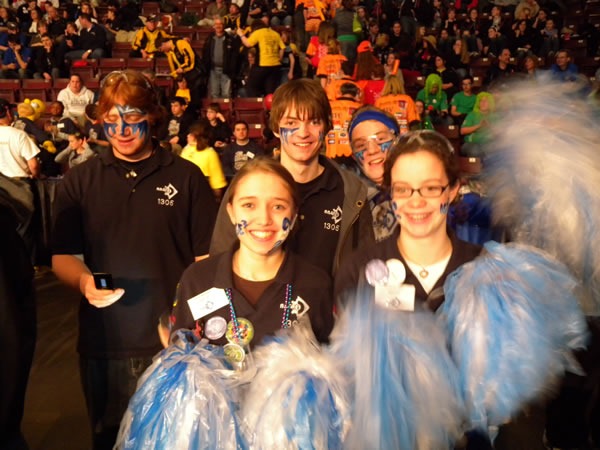
and there were team mascots, some with more expensive costumes:
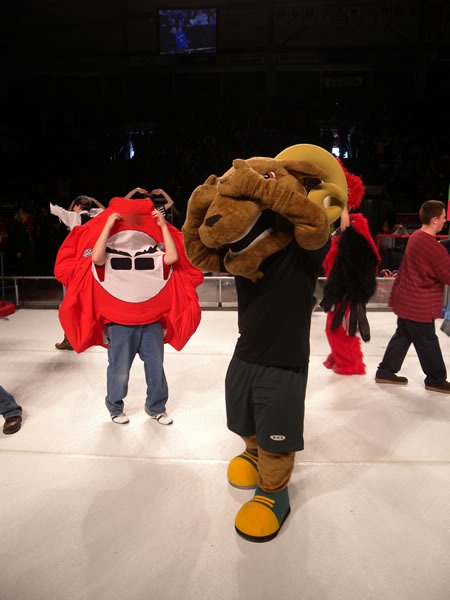
and some more economical costumes:
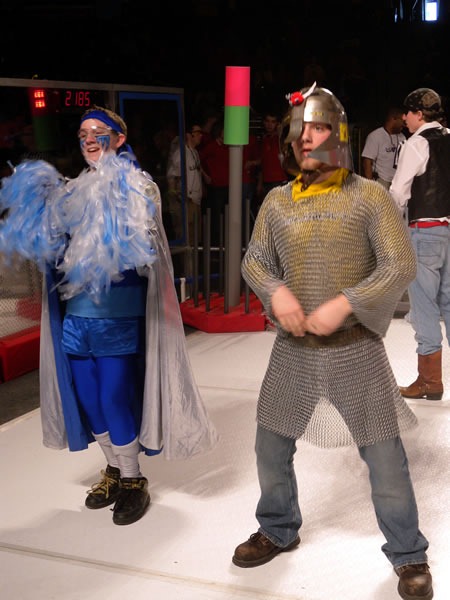
It wasn’t just the fans who dressed up. Many teams had their own uniforms, such as the Theory 6 team, pictured below:
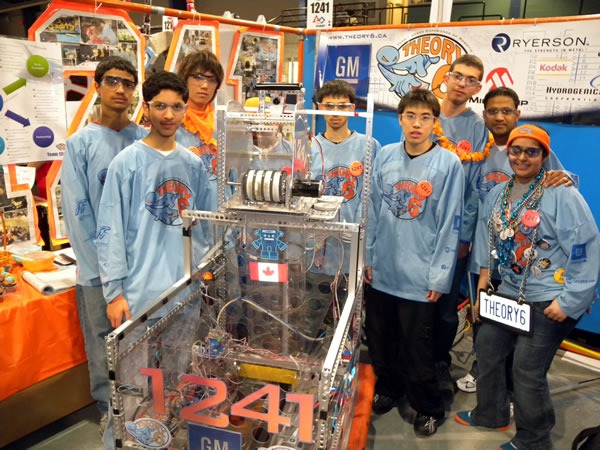
as did the all-girls Where’s Waldo? team – both they and their fans dressed up like Waldo from the Where’s Waldo? series of books:
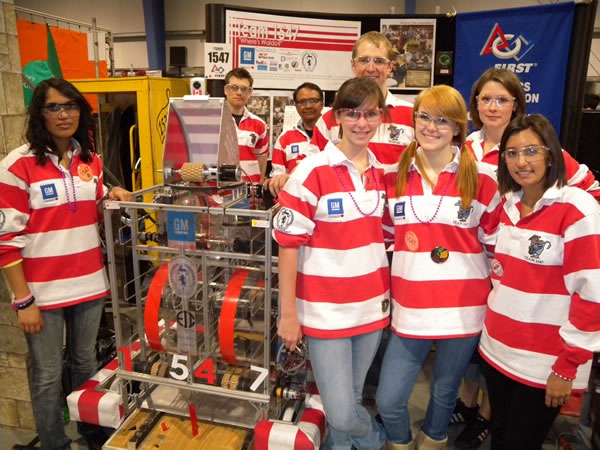
and one team took its costume cues from the world of professional wrestling:
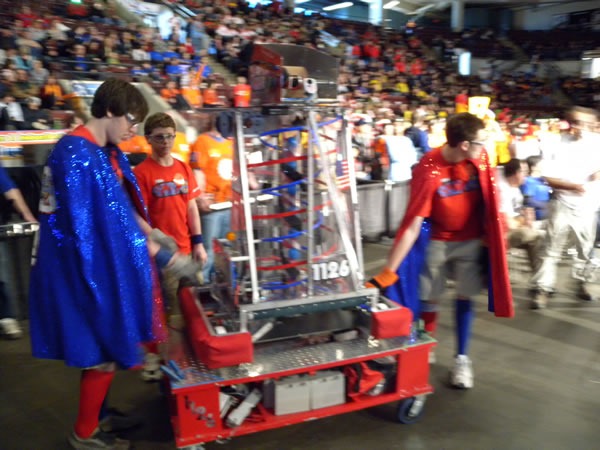
There’s a buzz that you can feel at certain conferences and gatherings of smart people who are passionate about what they do. I’ve felt it at gatherings like DemoCamp, PDC, RubyFringe and HacklabTO, and I definitely felt it at FIRST. The students there worked for months on a task that most adults would find daunting: building six-foot robots weighing around 120 pounds capable of running both autonomously and under human control.
In spite of being a competition with ambitious participants, there was also an air of good sportsmanship and bonhomie on the part of both the contestants and the officials, which was evident from the big things like the multi-team handshake ceremony…
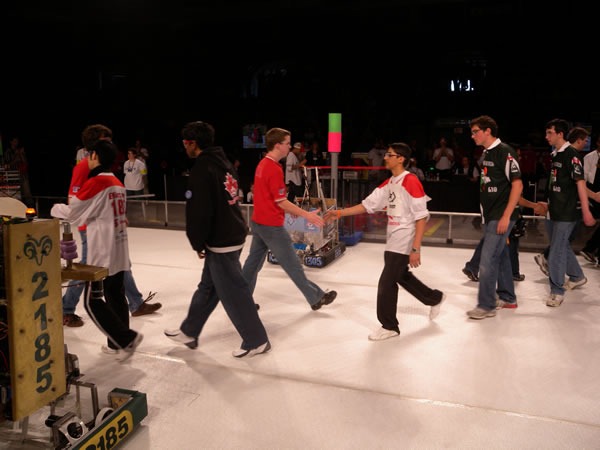
…to the way the teams interacted when they were side by side at their robots’ controls…
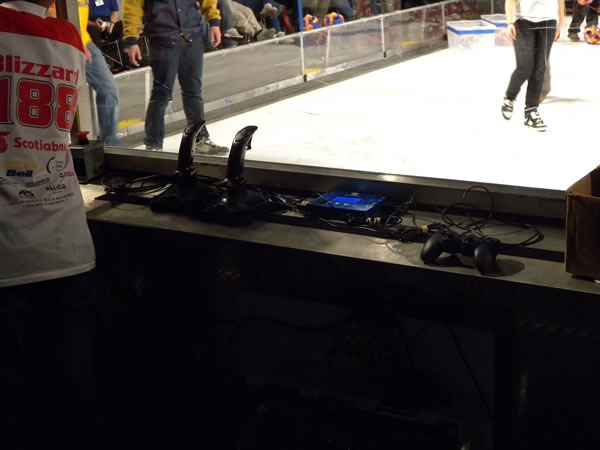
…and even to the way the mascots cooperated to entertain the audience during the breaks between matches:
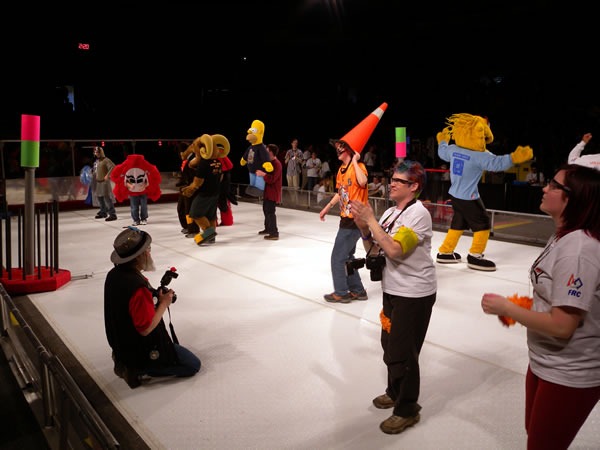
I had a blast watching the competition and found myself cheering as the robots (and the student pilots) pulled some pretty impressive moods. The experience was even better, thanks to the VIP pass that the local FIRST people gave me, which let me get right up to the edge of the playing field to see the action up close and into the pit where I could talk to the participating.
The students were a bright, ambitious and enthusiastic bunch. When they heard I was from Microsoft, they started peppering me with questions:
- “Is it true that I can write XBox games and sell them online?” (Yes.)
- “How do you get a job at Microsoft?” (Hard work and networking.)
- “Should I learn Visual Basic or C#?” (It depends.)
- “Can you hook me up with a free copy of Gears of War 2?” (Sorry, but if I give you one, I’m going to have to everybody here one.)
I told them about the DreamSpark for High Schools program, and they got really excited. This is exactly the sort of crowd I’d love to give free copies of Visual Studio and other tools to: smart, passionate people who get excited about building things.
My congratulations to the students at the FIRST Robotics Competition, and my thanks to the organizers for inviting me!
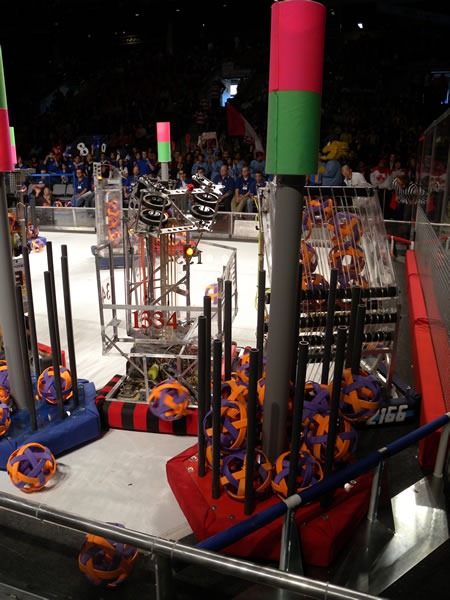
2 replies on ““Lunacy” at the FIRST Robotics Competition”
Wow that looks like so much fun…
I wish my school had ROBOT BATTLE CLUBS!
WOOOOOOO
[…] The Hive’s center area is a large space for people participating in various robotics classes and competitions, including the FIRST Robotics Competition (which I wrote about on my tech blog, Global Nerdy): […]